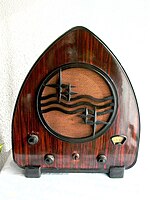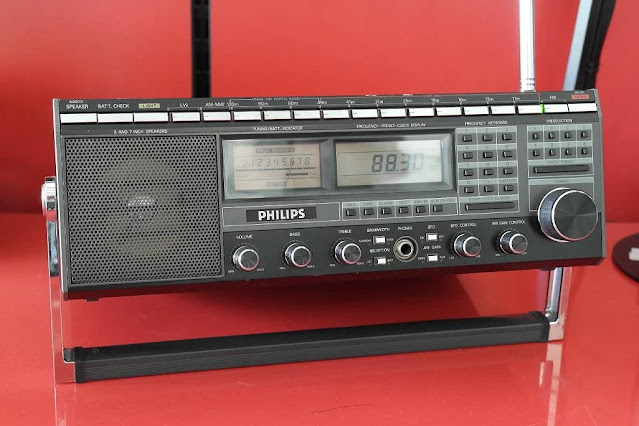Trust In Philips Is Worldwide
On 5/15/1891 Frederik Philips and his son, Dr. Gerard LF with 75,000 guilders started a light bulb factory in Eindhoven. By 1894 Philips already employed 35 staff and the younger son, Dr. Anton F. Phillips, joins the company as commercial director. Philips in 1903 is the fourth largest bulb factory in Europe. In 1912 the name is slightly changed.
With good technical developments, good marketing and decentralized manufacturing developed the Philips home to the largest radio manufacturer in the world. The company sells to 1934 100 million radio valves [156-122], and employs approximately 30,000 employees worldwide in 1935 [513 506]. 1942 founded the North American Philips Philips Inc. (Norelco) on the American market and is shortly after the end of the war there, the Canadian Radio Corp.. Ltd.., The manufacturer take the Rogers-Majestic-tubes. In about 1955, Philips also bought the Amperex Electronic Products Inc. in New York, which produces mainly commercial tubes.
https://www.radiomuseum.org/forum/philips_and_model_numbering.html https://www.radiomuseum.org/m/philips_nl_fr_noindex_1.html 5198 products !!! Philips & Co was founded in 1891 in Eindhoven, the Netherlands, by Frederik Philips and his son, Gerard. Recognizing the opportunity presented by the mass-market introduction of electricity, and inspired by Gerard’s keen interest in scıence and engineering, the pair soon conceived a bold but timely plan: cost-effective, reliable electric incandescent light bulbs. Koninklijke Philips N.V. (lit. 'Royal Philips'), commonly shortened to Philips, is a Dutch multinational conglomerate corporation that was founded in Eindhoven in 1891. Since 1997, it has been mostly headquartered in Amsterdam, though the Benelux headquarters is still in Eindhoven. Philips was formerly one of the largest electronics companies in the world, but is currently focused on the area of health technology, having divested its other divisions. The company was founded in 1891 by Gerard Philips and his father Frederik, with their first products being light bulbs. It currently employs around 80,000 people across 100 countries.[2] The company gained its royal honorary title (hence the Koninklijke) in 1998 and dropped the "Electronics" in its name in 2013,[3] due to its refocusing from consumer electronics to healthcare technology. The Philips Company was founded in 1891, by Dutch entrepreneur Gerard Philips and his father Frederik Philips. Frederik, a banker based in Zaltbommel, financed the purchase and setup of an empty factory building in Eindhoven, where the company started the production of carbon-filament lamps and other electro-technical products in 1892. This first factory has since been adapted and is used as a museum.[6]  In 1895, after a difficult first few years and near-bankruptcy, the Philipses brought in Anton, Gerard's younger brother by sixteen years. Though he had earned a degree in engineering, Anton started work as a sales representative; soon, however, he began to contribute many important business ideas. With Anton's arrival, the family business began to expand rapidly, resulting in the founding of Philips Metaalgloeilampfabriek N.V. (Philips Metal Filament Lamp Factory Ltd.) in Eindhoven in 1908, followed in 1912, by the foundation of Philips Gloeilampenfabrieken N.V. (Philips Lightbulb Factories Ltd.). After Gerard and Anton Philips changed their family business by founding the Philips corporation, they laid the foundations for the later multinational. In the 1920s, the company started to manufacture other products, such as vacuum tubes. In 1924, Philips joined with German lamp trust Osram to form the Phoebus cartel.[7] RADIO On 11 March 1927, Philips went on the air, inaugurating the shortwave radio station PCJJ (later PCJ) which was joined in 1929 by a sister station (Philips Omroep Holland-Indië, later PHI). PHOHI broadcast in Dutch to the Dutch East Indies (now Indonesia), and later PHI broadcast in English and other languages to the Eastern hemisphere, while PCJJ broadcast in English, Spanish and German to the rest of the world.[citation needed] The international program Sundays commenced in 1928, with host Eddie Startz hosting the Happy Station show, which became the world's longest-running shortwave program. Broadcasts from the Netherlands were interrupted by the German invasion in May 1940. The Germans commandeered the transmitters in Huizen to use for pro-Nazi broadcasts, some originating from Germany, others concerts from Dutch broadcasters under German control.  In the early 1930s, Philips introduced the "Chapel", a radio with a built-in loudspeaker. Philips Radio was absorbed shortly after liberation when its two shortwave stations were nationalised in 1947 and renamed Radio Netherlands Worldwide, the Dutch International Service. Some PCJ programs, such as Happy Station, continued on the new station. https://en.wikipedia.org/wiki/Radio_Netherlands_Worldwide https://en.wikipedia.org/wiki/Philips Collection of Ali DX on Facebook The MEDIUM WAVE and SHORTWAVE Philips radios A lot of radios receivers was made by Philips sinces 30's I have try to find some models for MW and SW listeners. The brand Philips was popular in Europe and all over the world. They have a lot of factory in the world. 1957 my parents buy this Philips radio and we use since the 80's |























.jpg)
.jpg)



.jpg)
.jpg)
.jpg)


.svg.png)




.jpg)


















Aucun commentaire:
Enregistrer un commentaire
Please indicate in your comment your amateur radio callsign, swl, or your email
Remarque : Seul un membre de ce blog est autorisé à enregistrer un commentaire.